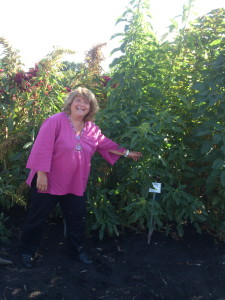It was the US government shutdown, believe it or not, that prevented me posting this item sooner. I needed to link to a GRIN entry, and the website was down for the duration of the stalemate, and then other stuff came up. Anyway, here we go at last.
A few weeks ago we had a meeting in Ames, Iowa, which included a visit to USDA’s North Central Regional Plant Introduction Station and its genebank. The germplasm collections at Ames are not just in the form of seeds. There are some medicinal and ornamental shrubs and trees around in the fields, and of course if you go at the right time of year you can see a lot of regeneration taking place in pollination cages. There are also some demonstration plots scattered around, and the amaranth one turned out to have a special resonance on this occasion.
 That’s because one of the accession involved, PI 482051, just happened to have been collected 30 years ago in Zimbabwe by my colleague Jane Toll, who was on the tour, and was very happy, as you can see from the photo, to be reunited with it. 1 David Brenner, the curator, swears it was just a coincidence…
That’s because one of the accession involved, PI 482051, just happened to have been collected 30 years ago in Zimbabwe by my colleague Jane Toll, who was on the tour, and was very happy, as you can see from the photo, to be reunited with it. 1 David Brenner, the curator, swears it was just a coincidence…
